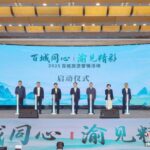Recently, the municipal government’s port and logistics office released data on Chongqing’s progress in the construction of the New Western Land-Sea Corridor in the first half of the year: cargo volume reached 154,600 TEUs, with a value of 28.332 billion yuan, representing year-on-year growth of 28% and 22%, respectively, achieving double growth.
Currently, amid global instability due to geopolitical conflicts and other factors, logistics faces significant pressure. Despite this, Chongqing has delivered a remarkable « double growth » performance in the New Western Land-Sea Corridor construction during this period.
As the operational and organizational hub of the New Western Land-Sea Corridor, Chongqing has been leading by example. In the first half of this year, the city expanded corridor routes, increased cargo value, strengthened inter-provincial collaboration, and encouraged more regions to participate, ensuring sustained, stable, and high-quality development of the corridor.
Breakthroughs in Three Logistics Models
At the end of May, a New Western Land-Sea Corridor rail-sea intermodal train loaded with auto parts, electronic components, and other goods departed from Tuanjie Village Central Station. Two days later, it transferred to a sea vessel at Qinzhou Port in Guangxi, heading to Laem Chabang Port in Thailand, completing the journey in under 10 days.
This train is part of Chongqing’s innovative « Premium Express » service on the corridor. Compared to traditional methods, the « Premium Express » allows containers to be returned 48 hours before departure, reducing rail transit time to under 32 hours and cutting overall transport time. The Chongqing-Laem Chabang route is three days faster than conventional methods.
This is the fourth « Premium Express » route to Southeast Asia launched by Chongqing. The corridor operates under three logistics models: rail-sea intermodal, international rail intermodal, and cross-border road transport. To further enhance efficiency, Chongqing has introduced new routes and services, including the « Premium Express » for rail-sea intermodal.
Innovation extends to international rail intermodal as well. In June, a China-Europe Railway Express (Chongqing-Xinjiang-Europe) arrived from Germany, with goods seamlessly transferred the same day to a New Western Land-Sea Corridor train bound for Vietnam. This marked the two-way operation of the « ASEAN Express » model.
The « ASEAN Express » is jointly operated by the New Western Land-Sea Corridor and the China-Europe Railway Express (Chongqing-Xinjiang-Europe). Customers only need a single consignment to access both corridors, enabling « one-container, one-bill » service and simplifying cross-border logistics between ASEAN and Europe.
As of June, the « ASEAN Express » has transported goods worth over 2 billion yuan, with routes connecting Duisburg (Germany), Chongqing, and Laos/Vietnam/Thailand. It serves high-end manufacturing sectors like automotive parts, pharmaceuticals, electronics, and household goods, reducing transport time by 50% compared to traditional shipping.
Meanwhile, cross-border road transport leverages its flexibility to handle smaller, more frequent shipments. In March, a « road-water intermodal » route transported auto and motorcycle parts from Chongqing to Myanmar, successfully testing the « Chongqing-Yunnan Guanlei Port-Mandalay » multimodal route.
In the first half of the year, cross-border road transport saw explosive growth, with 7,593 trips (up 194%) and cargo value of 8.026 billion yuan (up 437%). By the end of June, the corridor covered 571 ports in 127 countries and regions, 20 more than last year.
Increased Cargo Value
In June, 10,000 sets of auto parts from Great Wall Motors’ Chongqing KD factory were shipped via the corridor’s rail-sea intermodal service to Thailand.
This utilized a pioneering « bonded KD parts export model » developed in collaboration with Yongchuan Comprehensive Bonded Zone and customs. The model enables consolidated customs clearance and warehousing, allowing shipments every four days with a value of 20 million yuan per batch, creating an efficient channel for Chongqing-made vehicles.
Similarly, in mid-July, 1,271 Changan vehicles were shipped to Qinzhou via « rail JSQ cars + ro-ro ships » for onward transport to the Middle East. This Chongqing-originated model improves efficiency by 10-15% and reduces costs by 8%, offering high capacity, fast loading, and enhanced safety.
Notably, this shipment marked the corridor’s first « chartered vessel » for vehicle exports, setting a record for single-batch volume and a value exceeding 120 million yuan



